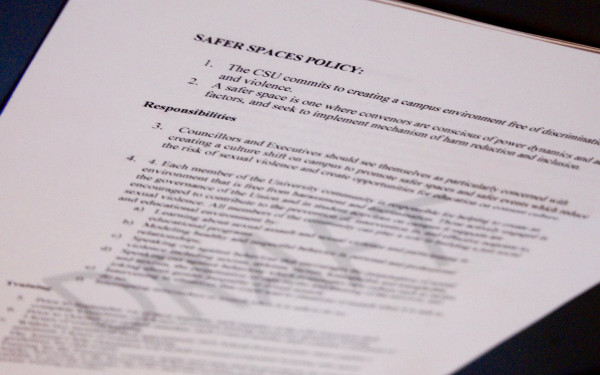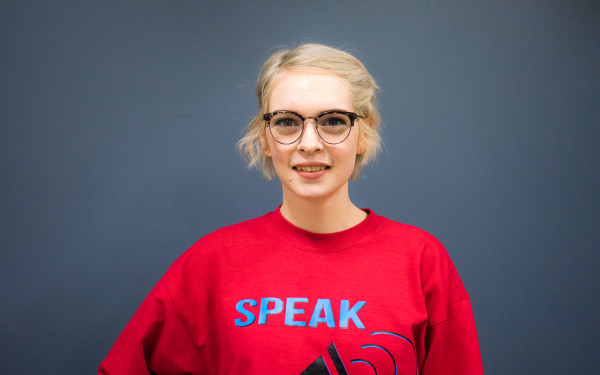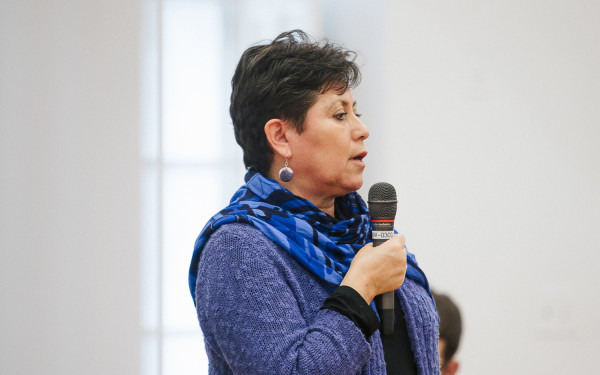Where’s Concordia Heading?
What Are Strategic Directions and How Will They Affect Your Life?
You’ve probably received emails from Concordia inviting you to partake in an “Idea Cafe” for its new strategic directions, trashed them and never thought to go.
Or you may have seen the directions advertised around campus on posters, just waiting to be tagged over.
These strategic directions have been in the works for over a year, mainly through committees of Concordia’s Senate, the university’s second highest decision-making body. Senate approved the first phase last summer, defining the nine directions the school plans to take.
Overall, most parties—students, staff and faculty—express optimism around how these directions can shape Concordia’s future. But depending on who you talk to, there may be some concern for what that future may look like.
“If you just see those words with the nine things, you might think this is just for show,” says Marion Miller, a student Senator and executive of the Concordia Student Union. “I’m willing to play along with the show if we get to talk about deep values of an institution—for me it’ll be a question of ‘do we get the results?’”
The second phase of strategic directions will be more action-oriented, according to Benoit-Antoine Bacon, Concordia’s Provost and Vice President of Academic Affairs.
The directions take into consideration Concordia’s history and strengths, but acknowledge that the institution needs to adapt, he says.
Goals and metrics are being determined to measure how well the directions will be implemented in the coming years, according to Bacon, but the provost won’t be around to see the results himself. Bacon recently announced he’s moving to Queen’s University in Ontario for the fall semester.
“The timing of his departure is regrettable when he has been a big contributor to the production of the document,” says Terry Wilkings, another student Senator and executive of the CSU. The new Provost, he says, will have a difficult time implementing directions he or she had no part in creating.
What these directions can do
Phase two is ongoing, but should be completed this semester. There aren’t many concrete examples yet of how the directions will be implemented, but committees at Senate are starting to discuss possible ideas.
“Get your hands dirty” became a direction because students consistently asked in surveys and discussions for more hands-on experience, according to Bacon.
Miller identifies with “Teach for tomorrow.” She believes both students and faculty want to have smaller class sizes where professors learn everyone’s names.
At a Senate meeting in December, Lisa Ostiguy, the school’s Deputy Provost, said for “Embrace the city,” they’re considering building a “one-stop hub” city space for Concordia students to meet with influential figures from around Montreal.
Cause for concern
Dealing with austerity measures—budget cuts—by the provincial government has been a consistent narrative for Concordia in the past few years. The university is working with a limited set of resources, Bacon admits, and says this set of strategic directions is not a “tool” to grow them.
Instead, he calls it an academic tool to help use resources more efficiently. Implementing the strategic directions properly could create a better international reputation for Concordia and potentially generate greater revenue, Bacon says.
“Right now is the really hopeful phase,” Miller says. “I think it is naive to say we’re going to push forward with budget compressions we’re facing from our current government and do all these nine great things.”
One of the keys to garnering this higher profile is through the first direction, “Double our research,” Miller believes.
“The research part is scary,” she comments. She’s been an opponent of this direction from the beginning since it’s the only one with a numerical value.
Concordia can’t become a big research university while equally valuing and promoting teaching, she argues.
“Professors should want to do research at our institution obviously, but if that takes away from teaching then that’s dangerous,” she says.
Emphasizing and marketing Concordia as one of the best research institutions could lead to more funding, especially from alumni, but doing so requires some sacrifice, Miller explains.
This sentiment was brought up at the December Senate meeting by a few Senators. Lana Galbraith, a student Senator, asked whether doubling research meant doubling the number of research assistants or increasing compensation for the existing ones.
Virginia Penhune, the chair of the psychology department, expressed her concerns at Senate that even if more money became available to hire full-time professors, they wouldn’t teach many classes.
Miller says creating a culture of hands-on experience that many students seek can lead to a more impressionable experience at Concordia.
“I don’t think we’ll make it if it’s about research,” she says. “If we make it about community engagement we’re onto something there.”
Environmental sustainability has also been pushed to the wayside in the strategic directions, Miller says.
“It’s funny how the university doesn’t want to focus on it even though it’s doing relatively well in [the field],” she says.
Trevor James Smith, a former student Senator, brought up this concern last year at a May Senate meeting when the first phase of the directions was almost unanimously passed. He talked about his concern at the time that the directions treated sustainability as a “niche” topic. He argued all students, regardless of program, should leave Concordia with a “general aptitude” in sustainability.
Miller says a Senate committee is examining how sustainability can be integrated into all nine directions, but she says it should have been there from the get-go, possibly as its own direction.
Students have a say
Attend any Senate session and you can see the involvement of the body’s student Senators, especially in regard to strategic directions.
“Our strategy has been to attack everywhere we can be in,” Miller says about a unified student movement. “When they’re talking about mix it up, we’re talking about interdisciplinary and community engagement. When they’re talking about [growing] smartly, we’re also trying to push sustainability.”
In the past academic plan, this wasn’t necessarily the case. In 2012, student Senators voted against the school’s academic plan for 2012-2016, according to Miller. While she wasn’t a student at the time, she says one committee constructed the plan without any student involvement.
Bacon says strategic directions have similar goals in spirit to the last plan, which was dubbed “Reaching Up, Reaching Out.” Only the specifics have changed to match changes in the world, he explains.
Both Bacon and Miller say the strategic directions will act as a guideline for where Concordia goes in the future. Holding the university accountable and making sure these directions translate into a better academic experience will be the job of students, Miller says.
“It’s always our job to be that voice because we’re the core of the university experience,” she says.

_900_600_90.jpg)
_600_832_s.png)




_600_375_90_s_c1.jpg)